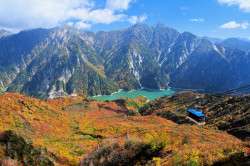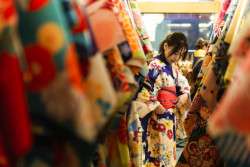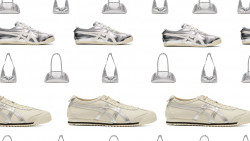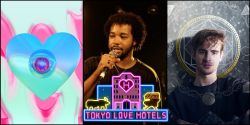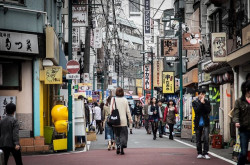
Originally published on metropolis.co.jp on November 2010
Christmas Lights: A Brief History

©Tokyo Midtown Management Co., Ltd.
For most of us, Christmas just wouldn’t be Christmas without a brightly lit tree festooned with tinsel. But where did it all begin? Popular theory says that the first person to stick candles on a tree was Martin Luther, who got the idea from seeing stars twinkling through the forest one winter night.
Japan’s first recorded illumination was held at the National Industrial Exposition in Osaka in 1903, and the following year, foreign goods importer Meidi-ya got the bright idea to decorate its storefront with colored lights at Christmastime. The twinkling display proved a hit with Ginza shoppers, and a tradition was born.
Dueling Trees
In 2004, Osaka’s Universal Studios added a new weapon to its Christmas arsenal. Rising to a height of 36m, the LED monstrosity known as the Universal Super Tree is the tallest freestanding artificial tree in Japan, and has drawn a reported nine million visitors since it was first unveiled. All that will change on December 10, as rival Kanto theme park Fuji-Q Highland reveals its brand-new Fujiyama Tree, which clocks in at a whopping 60m tall and contains 100,000 LED bulbs.
Timeline
- 2009 Omotesando Illumination resumes
- 1998 Omotesando Illumination axed because of over-crowding
- 1996 Nagasaki’s Kirakira Festival starts
- 1995 Kobe Luminarie starts
- 1991 Omotesando Illumination starts
- 1988 Takamatsu’s Dream Illumination starts
- 1987 Niigata Hikari no Pageant starts
- 1986 Sendai Hikari no Pageant (Pageant of Light) starts
- 1983 Tokyo Disneyland’s Christmas Fantasy starts
- 1981 Sapporo White Illumination, Japan’s first large-scale public light festival, opens using 1,048 bulbs
- 1976 Mikimoto Honten in Ginza puts up its jumbo Christmas tree for the first time
- 1931 Mitsukoshi begins selling Christmas lights
- 1921 Santa Claus makes his Japanese film debut in Shochiku’s Rojo no Reikon
- 1904 First Christmas tree displayed at Meidi-ya
- 1874 First Santa Claus makes his appearance at a Japanese Christmas party
Source: www.christmasmuseum.jp
AKASAKA/ROPPONGI
Akasaka Sacas
White Sacas 2010-2011. Until Feb 14, daily 5pm-midnight. Nearest stn: Akasaka. www.sacas.net
Roppongi Hills
Artelligent Christmas 2010. Until Dec 25, daily 5-11pm. Nearest stn: Roppongi. www.roppongihills.com
Tokyo Midtown
Midtown Christmas 2010. Until Dec 26, daily 5-11pm. Nearest stn: Roppongi. www.tokyo-midtown.com

GINZA/MARUNOUCHI
Marunouchi
Bright Christmas 2010. Until Dec 25, daily 6pm-12:30am. Nearest stn: Tokyo. www.marunouchi.com/marubiru
Yurakucho Mullion
Beauty Etoile Xmas. Until Dec 25, daily 9am-midnight. Nearest stn: Yurakucho.
HARAJUKU/AOYAMA
Omotesando-Dori
Omotesando Illumination 2010. Until Jan 10, daily 5-9pm. Nearest stn: Omotesando. www.omotesando.or.jp
Omotesando Hills
Omotesando Hills Christmas 2010. Until Dec 25, daily 11am-11pm. Nearest stn: Omotesando. www.omotesandohills.com

SHIBUYA/EBISU
Bunkamura
Bunkamura Christmas Illumination 2010. Until Dec 25, daily 4:30-10:30pm. Nearest stn: Shibuya. www.bunkamura.co.jp
Yebisu Garden Place
Baccarat Eternal Lights 2010. Until Jan 10, daily 4-11pm (Dec 17-26, until 1am). Nearest stn: Ebisu. www.gardenplace.jp

SHINJUKU/IKEBUKURO
Shinjuku Terrace City
Illumination ’10-’11. Until Feb 14, daily 5pm-midnight. Nearest stn: Shinjuku. www.odakyu.jp/terrace-city
Tokyo Opera City
Tokyo Opera City Christmas 2010: The Brilliant Party Time! Until Dec 25, daily 11:30am-11:30pm. Nearest stn: Hatsudai. www.operacity.jp
OTHER AREAS
Caretta Shiodome
Caretta Ocean Xmas 2010: Blue Ocean. Until Jan 10, daily 5-11pm. Nearest stn: Shiodome. www.caretta.jp
Decks Tokyo Beach
Daiba Memorial Tree 2010. Until Dec 25, daily 5pm-midnight. Nearest stn: Odaiba Kaihin Koen. www.odaiba-decks.com
Landmark Plaza
The Landmark Christmas. Until Feb 28, daily 5pm-midnight. Nearest stn: Sakuragicho. www.yokohama-landmark.jp
Motomachi Shopping Street
 Motomachi Twinkling Christmas 2010. Until Feb 27, daily noon-1am. Nearest stn: Motomachi-Chukagai. www.motomachi.or.jp
Motomachi Twinkling Christmas 2010. Until Feb 27, daily noon-1am. Nearest stn: Motomachi-Chukagai. www.motomachi.or.jp
Tokyo Dome City
Super Light City 2010. Until Feb 14, daily 5pm-1am. Nearest stn: Suidobashi. www.tokyo-dome.co.jp
Tokyo Tower
Christmas Illumination 2010. Until Dec 26, daily 9am-midnight. Nearest stn: Akabanebashi. www.tokyotower.co.jp
Venus Fort
Night Venus—All Love from the Heavens. Until Mar 14, 30 mins on the hour, daily noon-10:30pm. Nearest stn: Tokyo Teleport. www.venusfort.co.jp
And Elsewhere…
Kobe Luminarie
Held each year in commemoration of the Great Hanshin Earthquake, this show-stopping exhibition features hand-painted bulbs designed by Italy’s Studio Festi and event producer Hirokazu Imaoka. Nightly from Dec 2-13. www.kobe-luminarie.jp
Toki no Sumika, Gotemba-Kogen
Using over three million bulbs, this gigantic illumination includes a recreation of the water shows held at Versailles, plus a 370m long tunnel of light and a 15m tall laser-light figure of storybook character The Little Prince. Until Mar 6. www.tokinosumika.jp/illumination
Nabana no Sato, Mie Prefecture
 Highlights of Mie’s couple-friendly illumination include a sea of blue LEDs in the “flower garden,” a 100m long rainbow tunnel, twin trees, and a glittering recreation of Mt. Fuji. In all, the display uses a whopping 5.8 million bulbs. Until Mar 13. www.nagashima-onsen.co.jp/nabana/illumination
Highlights of Mie’s couple-friendly illumination include a sea of blue LEDs in the “flower garden,” a 100m long rainbow tunnel, twin trees, and a glittering recreation of Mt. Fuji. In all, the display uses a whopping 5.8 million bulbs. Until Mar 13. www.nagashima-onsen.co.jp/nabana/illumination
Sagami-ko Illumillion, Sagamihara
Deep in a mountain forest, this sprawling display is one of the largest in Kanto, with some two million lights. Attractions include an LED maze and a pink-and-white illuminated flower garden. The park also features a Ferris wheel and pair ski lift, plus a few special light displays that can only be appreciated from above. Until Apr 10. www.sagamiko-resort.jp/illumillion
Q&A
When you’re strolling hand-in-hand through a field of twinkling lights, it’s easy to get lost in the magic of the moment. We don’t stop to think about the fact that all this sparkle started out as nothing more than an idea in someone’s head—someone like Kimi Hasegawa. After graduating from Kuwasawa Design School, this self-professed “kuukan designer” went on to form Velveta Design Office, of which she is now the managing director. In addition to creating stores and spaces for Tokyo Designers’ Week, Hasegawa is the driving force behind the Omotesando Hills and Omotesando Street illuminations.
 How did you get started as a kukan designer?
How did you get started as a kukan designer?
I first became interested in “spaces” in elementary school, when I went on a trip to Southern France with my family. We were inside a dim, gloomy church; all of a sudden there was a gap in the clouds and sunlight poured in through the stained-glass windows, throwing blue patterns all over the floor. For a moment, the whole church was in an uproar and I was so moved I was shaking. That was when I realized how interesting it could be to change the appearance of spaces. I knew I wanted to do something that could move people like that.
What’s the hardest thing about making a large-scale project like the Omotesando Illumination?
A giant project like this involves so many people, and everyone has an opinion. You have to move forward consistently and carefully, while taking care to prioritize your initial concept.
How far in advance do you start planning?
It really depends on the time it takes to put the installation together, and the people involved; you’d have to give me more
specifics (laughs).
What do you think of the recent “eco illumination” trend?
I love that the use of LED lights is spreading. They can cut electricity consumption by 10-12 percent, so it helps the environment. Even better, LEDs have expanded the range of colors and movement and the kinds of forms that we can create with light, which makes the designs richer as well.
What makes a great illumination?
You have to know what kind of space you want to create, what feelings you want to draw from the people who visit. In the end, things like how many thousands of bulbs you used or the fact that you created a new, original color are just functions, and aren’t really important. The focus should be on creating feelings, conveying a message, and putting a smile on the faces of the people who visit.
 Why do you think illuminations are so popular in Japan?
Why do you think illuminations are so popular in Japan?
It’s not just Japanese—people everywhere love them. When I have the time, I travel to see illuminations around the world. I think the extraordinary, illusory spaces are fascinating for people.
What is it like when you first see the finished product?
As a designer, it’s an ecstatic moment, but it’s also very tense. It’s like waiting to hear a sentence handed down—the results of all your work depend on that one moment.
